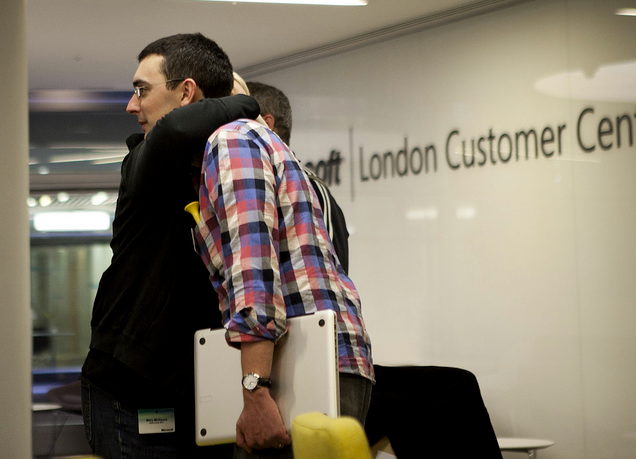
At heart, I’m an evolutionary, softly-softly kind of digital person, so I instinctively disapproved of chunks of Martha’s report. But even I can appreciate that, amid the destruction GOV.UK has wrought amongst the websites of Whitehall, there are some breathtaking vistas to a new way of doing things thanks to the mantra of ‘revolution, not evolution’.
DCMS wouldn’t have ripped apart its intranet in the same way without GDS’ inspiration and encouragement, for one. The quick answers that really answer the question. The radical presentation of government – not departmental – policy is another. Despite the awards, I think the jury is still out on whether tidying up the lawn to make policy accessible to new audiences was worth alienating the existing ones, currently screaming at departmental web teams around Whitehall.
But the work (and inevitable shouting) going on to improve transactional services and content publishing aren’t having the same effect on digital engagement, where many people I’ve talked to recently are evolving their approaches rather than developing explosive new ones. There’s a sense of needing to focus more clearly, to avoid being distracted by yet another request for a Twitter Q&A or microsite. Some are weary that the lauded examples are of shiny platforms, rather than transformed process and attitudes – which is happening, in progressive pockets of the Civil Service.
I’m not sure the GOV.UK grenades that work against bad online services will shift the culture of policy teams or ministers, which aren’t operationally-focussed or so vulnerable to bald financial arguments in the same way. So I’m left wondering if the softly-softly, pat-on-the-head approach to digital engagement is ever going to break through and scale. Or if we’ve all just been wasting our time.
I was sorry to miss yesterday’s Teacamp where open policymaking was on the agenda, but the tweets inspired me to a thought experiment: what would a really revolutionary approach to digital engagement look like? Something that would, by, say summer 2014, have the same impact on open policymaking as GOV.UK has had on departmental websites.
Here’s a few ideas, some quite daft:
- Every government policy team (minus the secret ones) blogging, without Press Office clearance, to make it truly part of everyday civil service life, and demystify communication. Bonus points for warts and all posts. Ride out the inevitable embarrassments.
- A strict ban on ghostwritten social media content, no matter how senior the ‘blogger’.
- Recruit a central team of 25 community managers, organised by audience group to build relationships with online communities of young people, parents, business owners and more with budget to back up those partnerships with financial support and help in kind.
- Support them with a ‘field force’ community management team ten times that size with individuals attached to every significant policy group, leading monitoring efforts, running partnership activity, shaping briefs and helping individuals when they get stuck.
- A minimum proportion of 30% of any marketing campaign budget to be spent on search, digital partnerships, content marketing, email or tactical social advertising – the stuff that takes effort to plan and manage, but generally beats conventional media and display advertising for efficacy.
- Harder rules about killing experiments with weak results within, say, 100 days – No Pinterest Without Demonstrable Interest.
- An independent commission to rewrite the Civil Service Code, to rethink the roles of Ministers, senior officials, and more junior officials in terms of engaging in policy discussion and taking responsibility for decisions. Alongside it, a frank Parliamentary discussion about the responsibilities of backbenchers and Opposition in holding government to account without stifling open policymaking.
- Every consultation with topics deemed of ‘general public’ interest to have a companion plain English document which asks different, clearly-worded questions about the issue at hand (and no more than 20 of them)
Some of these thoughts have been sparked by a new role I’ve just taken on (along with Anthony Zacharzewski from Demsoc, Simon Burall from Involve and others) as part of an independent panel on the Consultation Principles, contributing to a review currently underway by the Cabinet Office, for the Minister for Policy, Oliver Letwin.
I’m keen that as well as helping to advise on whether reducing the 12 week ‘rule’ on consultations was a good idea and what should happen next, we don’t miss the opportunity to describe how informal digital engagement (speaking to a variety of audiences) should complement formal consultation process (usually speaking to a more professional policy audience of membership bodies and lobby groups). They’re clearly not the same thing, but there’s a risk that we further erode the credibility of digital engagement unless we can say what it is, who it’s for, and how it’s done properly.
So, help me and the other Panel members: how can we improve open policymaking using digital methods, not just in progressive pockets, but across the whole of government?



Comments
Good stuff Stef – I like your bullets 3,4,5. The government is missing a huge trick in that online space.
Love this. Yes, time to rethink not evolve.
Another point is around the actual structure of departments and their fifedoms, rather than a structure more mirrored around themes/audiences. There have been vague mootings of this in the past but something worth thinking of. Comms is sort of trying it with the Hub approach but i’m not convinced it is actually working. Needs to start higher up.
I am not sure that revolution or at least the mindset of revolution can work. Given the right conditions, I think it is possible to spark an exponentially-growing evolution that, if you blink, might look like a revolution. The strategies would be quite different.
Beyond the navel gazing and also yet more navel gazing at Gov.UK towers there are still some of us that actually remember what was in the Digital Messiah’s report. Before her self-aggrandisement finally paid off and she was made prefect and head girl.
“Be agile
Radically reduce the size of the central organisation. Establish digital SWAT teams combining Directgov, Departmental and external expertise to immediately start work on flagship channel shift transactions. Bring in an external Turnaround Director to plan, run and manage the transition to the new delivery model.”
AND
Transformation milestones
Apr 11 – Mar 12
Launch flagship transactions
Those words were presented to the minister in Nov 2010. So much for revolution. This feels more like the Hundred Years War. And the battle continues over transactions STILL branded Directgov. The Driving Theory test was down for a few days recently, Student Finance remains a disaster. And if you’re a ‘jobseeker’ then God help you.
As for “Radically reduce the size of the central organisation,” that would be hilarious if the carnage hadn’t been so tragic. How many staff are they up to now 150? More?
If I remember correctly more than half of all visits to government websites are through transactions. When I asked @marthalanefox on twitter (in autumn 2011) about transactions she said this “just you wait buddy!” I asked her again one year later and it was all ‘yes, yes, but look at creation of GDS, work on gov.uk etc etc.’ But still NO work on transactions.
But hey, maybe we can look forward to seeing Martha dressed up as Henry V, a hundred years from now crying Harry, St George and England! Or maybe she’ll go down the Joan of Arc route. Who knows? Who cares! Just GET ON WITH IT.
[…] blogpost stems from the Open Policy Teacamp that Puffles and I went to on 2 May, and from this article by Steph Gray, who you really should be following if you are interested in public sector social […]
That’s interesting. I suppose the challenge here is that it takes courage, and there are risks for the first-movers (as I suppose there are in other revolutionary scenarios…). Do you see a way to achieve large scale cultural change without mandating/centralising?
I think they are, basically. These things are pretty monstrous, as you know, but I’ve been quite impressed they’ve put some of their best people on the case, doing the unglamorous work.
Time for a Power of Information II? Is Tom S still up for doing more of that kind of thing with Government these days?
One of my big unknowns is what the impact of ‘higher up’ really is in the civil service. The lesson of GDS is that anything is possible if you know your boss will be there for you – in any large corporate organisation, that’s the level up to which innovation and positive risk-taking happens I think.
But I worry about relying too much on the civil service grown-ups to cascade good things down to the troops.
Points 3 and 4 could really cut across boundaries – but as a lot of their work would be non-digital, its harder to see who might be the champion of this sort of activity – as Ann comments above, not really how the hubs are set up. And as commentators say, with a champion, in the way that GDS obviously have, anything is possible. Without, nothing tends to happen beyond good ideas and what individuals can do.
Your point about eroding the credibility of digital engagement is a good one. We’ve been advocating that people use the National Principles for Public Engagement in Wales (www.participationcymru.org.uk/principles) for their online as well as offline engagement, as there’s a danger that online work can be seen as a ‘quick and easy’ way to engage without being planned or harnessed effectively. The UK Government Consultation Principles could be used in a similar way, as benchmarks to evaluate against. Our Evaluation Toolkit (http://www.participationcymru.org.uk/principles/evaluation-toolkit), which is based on the Welsh Principles may be useful in this context.
Sorry for the self-promotion, just thought it might be useful! Great blog by the way!
Your principles are great – I point people their way quite often!
Thank you! Much appreciated!
Good point, Julia. In some ways, Sir Bob Kerslake is setting a promising lead. But ultimately I guess I’m arguing that even *with* a champion, maybe scaling up digital engagement will take lots of people and budget, and a rethink of the civil service rules – and those are big asks.
[…] Time for revolution rather than evolution? […]
[…] wonder if others winced as I did at the “pat-on-the-head” phrase Steph used in his blog about government digital engagement the other day. I winced because it rang […]
Great blog, and responses.
My experience is more in Local Gov policy-making and engagement rather than Central Gov, and I’m currently in the middle of a Masters research study on attitudes to rational models of policy-making in Local Gov.
I would offer a perspective that most of the academic and ‘professional’ literature on good policy making has tended to focus on process – typically describing good policy making in the form of a life-cycle of some sort. Here we can generally find engagement sprinkled in at different stages of the policy process. All well and good.
And what tends to be underplayed is the role of behaviour. Yet the majority of senior policy-makers that I’ve worked with and interviewed put behaviour ahead of process in terms of importance and impact on the ‘quality’ of policy making.
From a personal perspective I yearn for a rational, process-centered, solution. That’s just they way that I’m wired. And yet I am increasingly of the opinion that process is second-fiddle, and while the behaviour of policy making is left to the oscillations of politics we will continue to struggle with this issue.
So, I offer to you, we can usefully consider how we can model and teach the optimum process(es) and behaviour(s) of better policy-making, and how digital engagement fits into these models.
Which leads me to a question for you learned colleagues: how would you describe the optimum behaviours that could enable [an evolution in?] digital engagement as a step towards open, better, policy making?
[…] de alguns departamentos sem precisar recorrer à boa e velha hierarquia. Na mesma linha, Steph Gray questiona se a abordagem “rolo compressor” utilizada para implementar a plataforma de publicação irá […]
I absolutely do see a way…
…but it does depend on the people who want to make the change (wherever they are in the organisational hierarchy) starting to think fundamentally differently about how they approach it.
Long story much shortened: change management in government is dominated, it seems to me, by a (Taylorist) mechanical model of management that these days is serving increasingly poorly. I believe we need to think much more organism and a lot less mechanism.
To do things differently of course there will be a need for new policies, new processes, new organisational structures and new people; but the mistake is to focus on creating these. If gardeners want new trees they do not commission tree designers, buy wood for trunks or employ leaf-fixing teams – they look for suitable seedlings, plant them, water them… I won’t go on.
And I don’t think those involved have to do anything particularly courageous – save perhaps in finding ways to keep big-booted managers from trampling the new plantings.
[…] de alguns departamentos sem precisar recorrer à boa e velha hierarquia. Na mesma linha, Steph Gray questiona se a abordagem “rolo compressor” utilizada para implementar a plataforma de publicação irá […]